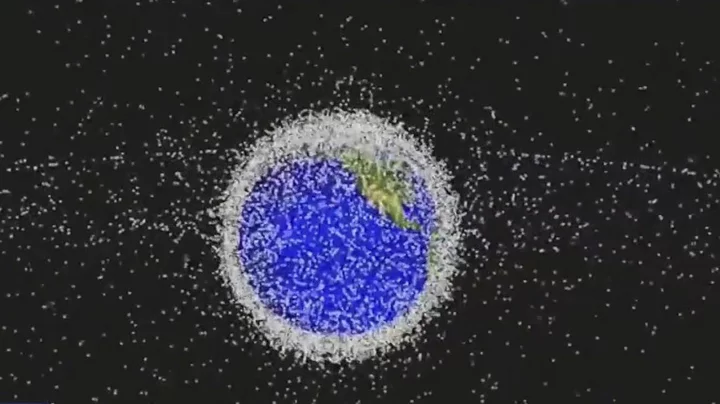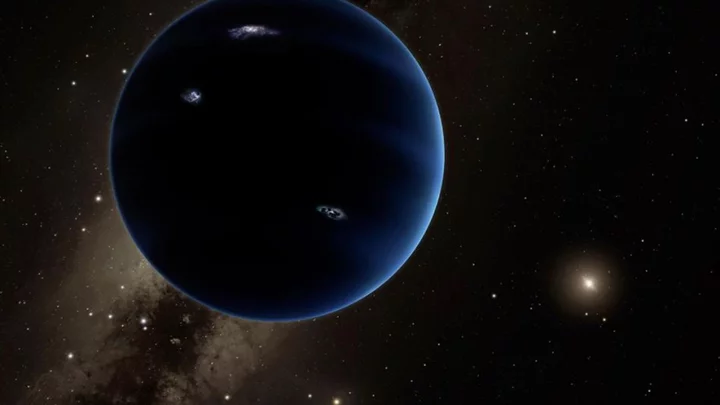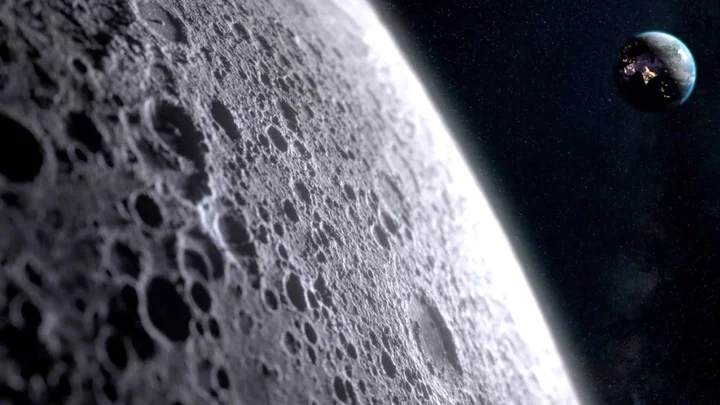
The Earth is being polluted by space junk, scientists discover
Minuscule traces of metal from space junk that's designed to be disposable are invisibly polluting the Earth's atmosphere, a new study has found. In recent times, spacecrafts launched into space have been designed so that they fall out of orbit and fall back down to Earth after their intended use. So instead of the materials crashing on land, they can burn up in the upper atmosphere. Although the debris of rockets and satellites burn up when re-entering the planet's atmosphere, the consequences of metal vapour being left behind currently remain unknown. But given the amount of space exploration taking place, the amount of metal vapour is expected to rise in the years to come. Physicist Daniel Murphy of the National Oceanic and Atmospheric Administration (NOAA) has led a team of researchers to investigate what effects this metal vapour could have as well as its impact over time and this study was published in Proceedings of the National Academy of Sciences, as per Science Alert. He listed "iron, silicon, and magnesium from the natural meteoric source" as the current refractory material in stratospheric particular. Murphy has warned how this composition could be affected by the metal vapour from space junk. "However, the amount of material from the reentry of upper-stage rockets and satellites is projected to increase dramatically in the next 10 to 30 years," he wrote. "As a result, the amount of aluminum in stratospheric sulfuric acid particles is expected to become comparable to or even exceed the amount of meteoric iron, with unknown consequences for inclusions and ice nucleation." To find out if metal vapour remained, Murphy and his team took and analyzed 500,000 stratospheric aerosol droplet samples to see if they had traces of spacecraft metals. Aerosols contain sulfuric acid droplets made from the oxidation of the carbonyl sulfide gas and in the atmosphere, this can appear naturally or as a pollutant. Metal and silicon traces can be found in these droplets too, acquired from meteors which vaporize upon atmospheric entry. Around 20 metals were discovered from this research, and while some metals had similar ratios to the vaporizing meteors, other metals such as lithium, aluminium, copper, and lead exceeded the anticipated amounts. Particles from vaporized spacecraft were found in 10 per cent of stratospheric aerosols over a certain size while other common spacecraft metals such as niobium and hafnium were also present. Consequently, these traces of spacecraft particles could affect how water freezes into ice in the stratosphere, and stratospheric aerosol particles could change in size. Due to more space exploration planned in an "era of rapid growth" for the industry, the researchers predict "the percentage of stratospheric sulfuric acid particles that contain aluminum and other metals from satellite reentry will be comparable to the roughly 50 per cent that now contain meteoric metals." Sign up to our free Indy100 weekly newsletter Have your say in our news democracy. Click the upvote icon at the top of the page to help raise this article through the indy100 rankings.
2023-10-17 18:50

A parasitic wasp with a giant head has been discovered and it's the stuff of nightmares
Scientists have unearthed a new species of wasp in the Amazon – and it's rather terrifying. The alien-looking parasitic creature came to light when a team at Utah State University were researching Allpahuayo-Mishana National Reserve in Peru. The wasp, known as Capitojoppa amazonica, has a giant almond-shaped head and is known to latch on to prey before sucking its blood and then eating it from the inside. It does so by laying eggs in its victims including caterpillars, beetles and spiders. The study’s lead author, biologist Brandon Claridge called the practice a "solitary endoparasitoid". "Once the host is located and mounted, the female will frantically stroke it with her antennae," Claridge told Live Science in an email. "If acceptable, the female will deposit a single egg inside the host by piercing it with her ovipositor (a tube-like, egg-laying organ)." He went on to explain that in some instances, "females will even stab the host with the ovipositor and feed without laying an egg as it helps with gaining nutrients for egg maturation." This isn't the first horrifying discovery, with researchers recently finding a new species of tarantula in Thailand that is characterised with illuminous blue legs. The spider is one of the rarest in the world, with Dr Narin Chomphuphuang explaining how it lurks in hollow trees. "The difficulty of catching an electric-blue tarantula lies in the need to climb a tree and lure it out of a complex of hollows," he explained. "During our expedition, we walked in the evening and at night during low tide, managing to collect only two of them." Sign up for our free Indy100 weekly newsletter Have your say in our news democracy. Click the upvote icon at the top of the page to help raise this article through the indy100 rankings.
2023-10-17 18:23

Scientists have discovered two giant mystery structures lurking under Africa
Many of us look to the stars for answers to life’s most complex questions. But actually, some of the greatest mysteries lie beneath our very feet. One might think we’d know the Earth pretty well by now but, in fact, our planet’s core remains shrouded in enigma. Indeed, there are two gigantic blobs located beneath Africa and the Pacific Ocean that occupy around six per cent of the world’s entire volume. And yet, we’re still not entirely sure what they’re made of or where they came from. There are a number of hypotheses, including that they are piles of oceanic crust that have accumulated over billions of years. Sign up for our free Indy100 weekly newsletter But a more interesting theory is that they are huge chunks of an ancient planet that hit the Earth around 4.5 billion years ago. To give an indication of just how massive these things are, the structure under Africa – an area known as Tuzo – is thought to be around 800km (497 miles) tall – the equivalent of some 90 Mount Everests stacked on top of one another, as IFLScience notes. The problem with determining the origin of these monster formations is that there are no direct ways of observing the Earth’s core. The deepest hole humans have ever dug – branded the "entrance to hell" – reached a pretty staggering 12,263m (40,230ft), but that doesn’t even come close to breaking through the crust to the layers beneath. Our most effective tool for analysing what lies beneath the ground is a technique called seismic tomography, which looks at how waves of energy travel when earthquakes occur. Since rocks and liquids have different densities, the waves move through them at different speeds. By measuring the tremors from different points on the surface, geologists can determine what kind of material the waves are travelling through and, in so doing, map out the Earth’s interior. It was by using this technique that the two unusual structures – known as large low shear velocity provinces (LLSVPs) – were found. Waves travel more slowly in these areas – fondly known as “blobs” – than through the surrounding lower mantle, indicating that they’re made of something different. We can’t tell what this material is based on seismic tomography data alone, but some scientists like to believe that they are the remnants of an ancient planet called Theia – an idea known as the “giant impact hypothesis”. According to this hypothesis, around 4.5 billion years ago, a Mars-sized object collided with the Earth. This impact not only created the planet we call home today, but also threw off enough rock to form the moon that lights up our night skies. Some scientists suggest that some of Theia’s leftovers also sunk to the bottom of the planet, probably settling somewhere above the core – thereby forming at least one of the two LLSVPs. More Updates About Strange Blob Structures Inside Planet Earth youtu.be Experts have been investigating the area for decades but there’s still no way of knowing for sure just what these two giant blobs are. Still, studies into Theia have offered important insights into how the possible collision might have kickstarted key plate tectonic and mantle motion inside our planet – crucial processes for establishing the world on which we live. It’s also a useful reminder that we still have so much to learn about our planet and where we came from. Have your say in our news democracy. Click the upvote icon at the top of the page to help raise this article through the indy100 rankings.
2023-10-17 14:56

This is why time ‘speeds up’ when we get older, according to scientists
We've all heard and probably have used the saying "time flies," but why does this expression resonate more and more as we get older? From being a happy-go-lucky child counting down the days of school left until the summer holidays to finding ourselves in adulthood with responsibilities like a full-time job and bills to pay, everything changes in what feels like a blink of an eye. While there isn't any scientific evidence that explains why we feel time moves faster as we age, there is a theory that may provide the answer. "One is that when we are older, we tend to have lives that are more structured around routines, and fewer of the big landmark events that we use to demarcate different epochs of the 'time of our lives,'" Cindy Lustig, a professor of psychology at the University of Michigan, told the Daily Mail. She explained how as children we have fewer experiences to reflect on. And so 20 per cent of a five-year-old's life is just one year and in this year there are momentous milestones and life experiences. While the same duration of time only two per cent of a 50-year-old's life who wouldn't have as many new experiences within this period. The professor added how our brains often merge similar days and weeks together and this blending of memories means that many of us can remember something they've done once rather than recalling the hundred times they have done it before. Well, there you go - something to think about whenever we feel old and like time is passing us by. Sign up to our free Indy100 weekly newsletter Have your say in our news democracy. Click the upvote icon at the top of the page to help raise this article through the indy100 rankings.
2023-10-17 14:15

Scientists discover that people who live past 90 have key differences in their blood
Centenarians have become the fastest-growing demographic group in the world, with numbers approximately doubling every 10 years since the 1970s. Many researchers have sought out the factors and contributors that determine a long and healthy life. The dissolution isn't new either, with Plato and Aristotle writing about the ageing process over 2,300 years ago. Understanding what is behind living a longer life involves unravelling the complex interplay of genetic predisposition and lifestyle factors and how they interact. In a recent study published in GeroScience, researches have unveiled common biomarkers, including levels of cholesterol and glucose, in people who live past 90. The study is one of the largest that has been conducted in this area, comparing biomarker profiles measured throughout life among those who lived to be over the age of 100 and their shorter-lived peers. Data came from 44,000 Swedes who underwent health assessments at ages 64-99. These participants were then followed through Swedish register data for up to 35 years. Of these people, 2.7 percent (1,224) lived to be 100 years old. 85 percent of these centenarians were female. The study's findings conduced that lower levels of glucose, creatinine - which is linked to kidney function and uric acid, a waste product in the body caused by the digestion of certain foods - were linked to those who made it to their 100th birthday. The findings suggest a potential link between metabolic health, nutrition, and exceptional longevity. In terms of lifestyle factors, the study didn't allow for any conclusions to be made, but the authors of the study added that it's reasonable for factors such as nutrition and alcohol intake play a role. Overall, the fact that differences in biomarkers could be observed a long time before death suggests that genes and lifestyle play a role, but of course, chance likely has an input too. Sign up to our free Indy100 weekly newsletter Have your say in our news democracy. Click the upvote icon at the top of the page to help raise this article through the indy100 rankings.
2023-10-17 00:21

Conspiracy theorists believe there is a secret planet
Conspiracy theorists think that there is a hidden planet in out Solar System that will eventually destroy humanity. That's right, conspiracy theorists believe there is a secret ninth planet that was discovered by 19th-century astronomer Percival Lowell. The planet was given the name 'Planet X', also known as Nibiru, by Lowell, who believed the inhabitants of the planet made humans who we are today. Despite Lowell never actually seeing the mystery planet, he was convinced of its existence and left $1 million to fund research about the planet after he passed away in 1916. A hundred years later and all the money spent, it was concluded that the planet never existed. But this hasn't stopped conspiracy theorists from vowing to continue the search. With Caltech professors Mike Brown and Konstantin Batygin even going as far as to co-author a paper suggesting the planet exists "I didn't have a particularly strong appreciation for just how difficult would be to find Planet Nine until I started looking together with Mike using telescopes," Professor Batygin told the BBC. "The reason it's such a tough search is because most astronomical surveys are not looking for a single thing." It was initially predicted that Planet X would bring about the end of the world in 2003, but it did not smash into Earth as had been suggested. In 2012 it was again predicted that the planet would collide with Earth at the end of the year, which I don't need to tell you, did not happen. Dr Scott Sheppard and Professor Chad Trujillo sought to explain a strange cluster of six small objects in the Kuiper Belt beyond Neptune back in 2014. They suggested that a large planet was lurking in the solar system, with Dr Sheppard saying: "These distant objects are like breadcrumbs leading us to Planet X. 'The more of them we can find, the better we can understand the outer Solar System and the possible plant that we think is shaping their orbits - a discovery that would redefine our knowledge of the Solar System's evolution." Sign up to our free Indy100 weekly newsletter Have your say in our news democracy. Click the upvote icon at the top of the page to help raise this article through the indy100 rankings.
2023-10-16 18:19

Older people could see a surprising health benefit from having an active sex life
A US study has revealed that sexual activity in older people is linked to better cognitive function later. The study by sociologists Shannon Shena from Hope College and Hui Liub from Purdue University, published in The Journal of Sex Research looked at attention, memory, language, conceptual thinking, calculations, and orientation and found that sex is linked to better brain health across all age groups. Those aged 75 to 90 were found to have significantly better cognitive function five years on if they were currently having sex at least once a week. For adults aged 62 to 74, on the other hand, the most important factor for future brain health was the quality of sex being had, in terms of both physical and emotional aspects. "As seen in our sample, promoting sexual quality among younger-old couples may be a way to combat the interruptions which people anticipate to come with aging," Shena and Luib said "and these feelings of sexual quality may manifest in their later cognitive health." Shena and Liub think there are several reasons why these results could be the case. Sex involves physical exercise, which means improved cognitive performance may be due to improved cardiovascular health, which, in turn, can increase blood flow to the brain and reduce inflammation. Sex can also reduce stress, and stress is thought to prevent the neuronal growth in some parts of the brain associated with memory. Finally, sex may improve cognitive function through the release of dopamine, which is a neurotransmitter linked to improved memory. "Our findings help to contextualize a multifaceted understanding of healthy aging and speak to clinical practices and policy decisions regarding cognitive health," Shena and Luib wrote, "and in particular how it may be related to sexual life, an often overlooked area for older adults." Sign up to our free Indy100 weekly newsletter Have your say in our news democracy. Click the upvote icon at the top of the page to help raise this article through the indy100 rankings.
2023-10-14 20:23

A hidden underground ocean could be causing ‘slow-motion' earthquakes
Scientists think they could have found the cause of a series of “slow-motion” earthquakes that have shaken New Zealand in recent years – a hidden ocean which sits two miles beneath the sea floor. The water was revealed as part of a giant volcanic area formed about 125 million years ago, when an eruption forced a plume of lava bigger than the US to the surface of the Earth. Researchers found the region by towing 3D seismic sensors behind a boat to build up an image of the ancient volcanic area. There, they found thick, layered sediments around long-buried volcanoes which contained much more water than expected. Andrew Gase, from the University of Texas Institute for Geophysics, who carried out the research, said: “Normal ocean crust, once it gets to be about seven or 10 million years old should contain much less water.” The ocean crust scanned by researchers was 10 times as old as this – but water made up nearly half its volume. The tectonic fault line which runs through New Zealand is known for producing slow-motion earthquakes, also known as slow slip events. During one of these, the energy from an earthquake gets released over days or months, often causing little or no harm to people. Scientists don’t know why they happen more at some faults than at others, but they are thought to be linked to buried water. Finding this new area of water at the fault line which creates so many slip events could provide an explanation. Gase said: “We can't yet see deep enough to know exactly the effect on the fault, but we can see that the amount of water that's going down here is actually much higher than normal.” If researchers can work out how the water reserves affect slip events – possibly by dampening them – they could, in turn, understand normal earthquakes better. Scientists also think underground water pressure could play a key part in creating conditions that release tectonic stress via slow slip earthquakes. As a result, Gase said scientists should drill even deeper to find out where the water ends up. Sign up to our free Indy100 weekly newsletter Have your say in our news democracy. Click the upvote icon at the top of the page to help raise this article through the indy100 rankings.
2023-10-13 22:50

Instagram has made an AI Kendall Jenner and it's scarily realistic
An AI version of Kendall Jenner is going viral after it was launched by Meta as part of Instagram introducing the future of technology on the app. Known as 'Billie' (@yoursisbillie), it's thought the Keeping Up With The Kardashians star was paid 'millions' to lend her face and voice to the account, which offers advice to fans - and it's near-impossible to tell it's not real. "I don't like this, I don't like where the world is heading, I'm not gonna support this," one terrified user wrote in the comments. Sign up to our free Indy100 weekly newsletter
2023-10-13 21:50

Low-flying helicopter sparks crazy crocodile orgy in Australia
Hundreds of crocodiles in Australia were recently sent into a sex frenzy when a low-flying Chinook helicopter passed overhead. Ranchers from the Koorana Crocodile Farm in Queensland, which houses more than 3,000 crocodiles, said many of their residents became aroused after the flyby. John Lever, owner of the farm, said pilots use it as a marker point in their flights. When a pilot flew low so their passengers could take a picture of the crocodiles, the reptiles were whipped up into a frenzy. He said: “All of the big males got up and roared and bellowed up at the sky, and then after the helicopters left they mated like mad. “There's something about the sonic waves that really gets them stirred up.” As it turns out, thunderstorms regularly act as an aphrodisiac to crocodiles. If the reptiles mate during storm season, their babies are more likely to hatch in a non-thunderstorm season, meaning they don’t drown in flood water. “The crocodiles start vocalising to each other [when a storm is coming],” Lever said. “They don't have a very sophisticated voice box, but they vibrate their windpipes to send messages through the water.” That may explain why the helicopter caused such an aroused response – they thought it was a megastorm. Herpetologist Mark O'Shea from the University of Wolverhampton told LiveScience: “Chinooks may artificially recreate the sound of the start of a thunderstorm.” Another possible explanation is that the movements in the water or downward wind caused by the choppers could trick them into thinking there is a change of atmospheric pressure, like when a storm is approaching. “I imagine that the downdraft from a large, heavy helicopter would create a change in pressure that the [sensory organs] on crocodile skin can detect. “Dropping barometric pressure from a downdraft may resemble the change in pressure from a storm.” Sign up to our free Indy100 weekly newsletter Have your say in our news democracy. Click the upvote icon at the top of the page to help raise this article through the indy100 rankings.
2023-10-13 20:51

Scientists could use lunar dust to make roads on the moon
Scientists have come up with a potential solution to deal with dust on the moon which makes conducting research tricky. Dust erodes space suits, clogs machinery, interferes with scientific instruments and makes moving around on the surface difficult. But they reckon moon dust could be melted using a giant lens developed by the European Space Agency to create solid roads and landing areas. Using a fine-grained material called EAC-1A, developed as a substitute for lunar soil, scientists used a 50mm diameter laser beam to heat the dust to about 1,600C and melt it. Then they traced out bendy triangle shapes, which could be interlocked to create solid surfaces across large areas of lunar soil to be used as road. However it would take about 100 days to create a 10 x 10m landing spot so it is not a quick fix. To make matters worse, the lens needed for the laser to work would be difficult to transport from Earth and could also get dust in it which may reduce its functionality. “You might think: ‘Streets on the moon, who needs that?’” said Prof Jens Günster, of the Federal Institute of Materials Research and Testing in Berlin and co-author of a report on the possible solution. “But in fact it’s a kind of depressing demand [even] early on. It’s very loose material, there’s no atmosphere, gravity is weak, so the dust gets everywhere. It contaminates not only your equipment but other nations’. No one would be happy to be covered in dust from another rocket." Dust has blighted previous missions, such as the Surveyor 3 spacecraft (damaged by dust kicked up by the Apollo 12 landing), and overcoming this challenge is a priority for Nasa, which aims to establish a permanent lunar outpost. Transporting building materials to the moon would be too expensive, so there is a need for unconventional solutions. “You need to use what’s there and that’s simply loose dust,” said Günster. The findings are published in the journal Scientific Reports. Sign up to our free Indy100 weekly newsletter Have your say in our news democracy. Click the upvote icon at the top of the page to help raise this article through the indy100 rankings.
2023-10-13 20:19

EU opens an investigation into Elon Musk's X over 'disinformation'
The EU has opened an investigation into Elon Musk's X over the possible spread of terrorist and violent content, and hate speech, after Hamas' attack on Israel. The EU's industry chief, Thierry Breton, confirmed on Thursday the bloc had sent Twitter/X a "formal request for information" to determine whether the platform was complying with the Digital Services Act (DSA) - a law designed to protect users of big tech platforms which came into effect November, as misinformation about the conflict between Israel and Hamas spreads on social media. In a statement on Thursday, the EU said “the European Commission services sent to X a formal request for information under the Digital Services Act (DSA)”. “This request follows indications received by the Commission services of the alleged spreading of illegal content and disinformation, in particular the spreading of terrorist and violent content and hate speech. The request addresses compliance with other provisions of the DSA as well.” In his letter to Musk, Breton said "violent and terrorist content" had not been taken down from X, despite warnings. Breton did not give details on the disinformation he was referring to in the letter, but said instances of "fake and manipulated images and facts" were widely reported on the social media platform. Responding on X, Musk said: "Our policy is that everything is open and transparent, an approach that I know the EU supports. "Please list the violations you allude to on X, so that the public can see them." X chief executive Linda Yaccarino also said earlier on Thursday the platform had removed hundreds of Hamas-affiliated accounts and taken action to remove or label tens of thousands of pieces of content since Saturday's attack. Sign up to our free Indy100 weekly newsletter Have your say in our news democracy. Click the upvote icon at the top of the page to help raise this article through the indy100 rankings.
2023-10-13 18:16
